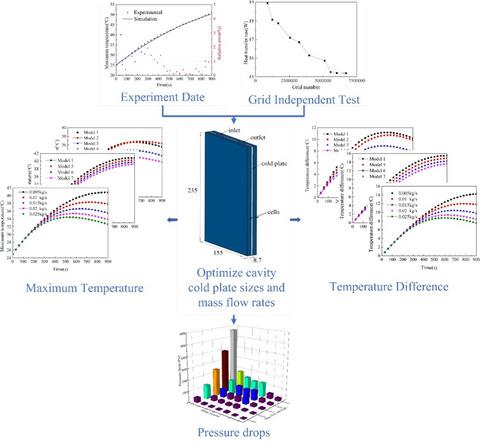当前位置:
X-MOL 学术
›
Energy Sci. Eng.
›
论文详情
Our official English website, www.x-mol.net, welcomes your
feedback! (Note: you will need to create a separate account there.)
Thermal management performance of cavity cold plates for pouch Li‐ion batteries using in electric vehicles
Energy Science & Engineering ( IF 3.5 ) Pub Date : 2020-09-21 , DOI: 10.1002/ese3.798 Tong Wang 1 , Xin Zhang 1 , Qingliang Zeng 1, 2 , Kuidong Gao 1
Energy Science & Engineering ( IF 3.5 ) Pub Date : 2020-09-21 , DOI: 10.1002/ese3.798 Tong Wang 1 , Xin Zhang 1 , Qingliang Zeng 1, 2 , Kuidong Gao 1
Affiliation

|
The cold plate cooling system has become one of the most practical and promising Li‐ion battery thermal management systems for electric vehicles. The existing cold plate has complex structure with high production cost, and the energy consumption is relatively high. In this paper, a detailed optimization study of cavity cold plate is carried out. The heat generation data of the pouch Li‐ion batteries were obtained through experiments, and the data were applied to the finite element method simulation of the cavity cold plate thermal management system. The effects of cavity cold plate thickness (d1), cold plate inlet and outlet width (d2), and inlet coolant mass flow rate on battery temperature and cold plate pressure drop were discussed. The results showed that the optimization allowed the cavity cold plate to control the battery maximum temperature within 40°C and temperature difference within 5°C. Under the same volume of cold plates, the average pressure drop reduction rates of models where Δd (the difference between d1 and d2) is 1 mm are 65% higher than that of the models where d2 is 1 mm. This study has practical significance for improving the design efficiency of cavity cold plate.
中文翻译:

电动汽车用锂离子电池腔冷板的热管理性能
冷板冷却系统已成为最实用,最有前途的电动汽车锂离子电池热管理系统之一。现有的冷板结构复杂,生产成本高,能耗较高。本文对型腔冷板进行了详细的优化研究。通过实验获得了袋装锂离子电池的发热数据,并将其应用于腔冷板热管理系统的有限元方法模拟。型腔冷板厚度(d 1),冷板入口和出口宽度(d 2)的影响),并讨论了入口冷却液质量流量对电池温度和冷板压降的影响。结果表明,该优化使型腔冷却板能够将电池的最高温度控制在40°C以内,将温度差控制在5°C以内。在相同体积的冷板,型号其中Δ的平均压降减少率d(之间的差d 1和d 2)为1mm比的是,当模式的较高65%d 2为1mm。该研究对于提高型腔冷板的设计效率具有现实意义。
更新日期:2020-11-16
中文翻译:

电动汽车用锂离子电池腔冷板的热管理性能
冷板冷却系统已成为最实用,最有前途的电动汽车锂离子电池热管理系统之一。现有的冷板结构复杂,生产成本高,能耗较高。本文对型腔冷板进行了详细的优化研究。通过实验获得了袋装锂离子电池的发热数据,并将其应用于腔冷板热管理系统的有限元方法模拟。型腔冷板厚度(d 1),冷板入口和出口宽度(d 2)的影响),并讨论了入口冷却液质量流量对电池温度和冷板压降的影响。结果表明,该优化使型腔冷却板能够将电池的最高温度控制在40°C以内,将温度差控制在5°C以内。在相同体积的冷板,型号其中Δ的平均压降减少率d(之间的差d 1和d 2)为1mm比的是,当模式的较高65%d 2为1mm。该研究对于提高型腔冷板的设计效率具有现实意义。











































 京公网安备 11010802027423号
京公网安备 11010802027423号